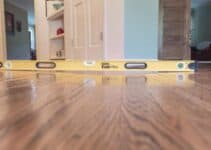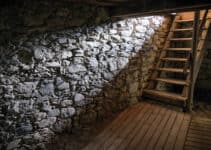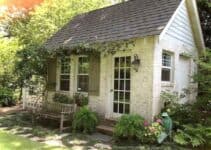The image of a house in a charming English village surrounded by birdsong most likely comes to mind when you hear the word “cottage”.
But “cottage” and “house” are technically two different terms referring to two distinct types of dwellings that can be vastly different from one another. What’s the difference between a cottage vs house? The main difference is its building features, but let’s look at both in more detail’.
What Defines a Property as a Cottage?
The origin of the term “cottage” can be traced back to the feudal system in England’s Middle Ages when a “cotter” (worker) was given somewhere to live by the Lord of the Manor in exchange for his service.
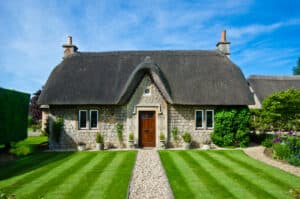
What is a Cottage House?
Historically, a cottage house was a small house in an agricultural community with a simple design with land surrounding it for peasants to grow food on.
The garden was a place for growing spuds and carrots, not roses and delphiniums. If and when flowers were planted, they were often put there for their (alleged) medicinal qualities.
Flowering herbs to cook bland food with or heal ailments were popularly seen in these “kitchen gardens”.
So that’s what a cottage house used to be. However, in today’s modern world, the word cottage conjures up images of a cosy and much desirable home to escape to, away from it all in the gently rolling countryside.
Hardly the home of peasants any more: more like the Lord of the Manor at the prices these buildings regularly exchange hands for.
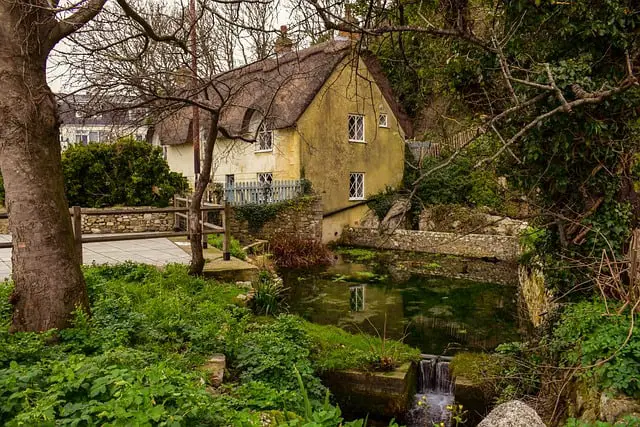
The Rise Of The Classic English Cottage
Helen Allingham was a Victorian artist whose idealised and very beautiful watercolour images of English cottages helped to create the modern appeal for the des-res building now engrained in the British psyche.
Picture Postcard Perfect
Helen Allingham’s work and other such works by Edwardian watercolour artists, A R Quinton et al, were printed in their tens of thousands as picture postcards.
In the days before the telephone, the postcard would be delivered within hours by a far more efficient postal service than the Royal Mail now, and thus was the modern equivalent of a phone call, email or text.
These cottage scenes would not just be seen on say, a postcard of a pretty Dorset village, but on birthday postcards or just really pretty art postcards.
Postcards were widely collected and treasured in family albums, and as postcards started flying here, there and everywhere around the country in a much greater era of travel over a widening railway network with people travelling further and further afield, so more and more of these scenes were printed in almost industrial quantities.
One of the most common images to find on an Edwardian postcard is of the classic English cottage: the reason being, the public liked buying these cards, sending them and collecting them.
As people started loving this idealised image and searching it out in shops, so it also appeared on things like little trinket boxes and other such gifts.
From Picture Postcards to Chocolate Boxes
The “picture postcard” scene had already become popularised and engrained in the public psyche by the time Cadbury started adding a picture of a cottage to the front of their Milk Tray chocolate boxes in the 1950s. (This picture was often a loose postcard within the packaging).
Chocolate has always been identified with love and romance, here in Britain at least. This, as well as being a clever marketing ploy for chocolate, also said on a subliminal level that the houses pictured on the lid were to love as much as the wonderful chocolates inside.
So that’s a little bit about the rise of the idealised version of a cottage, let’s look at what makes a house.
What Makes a Building A House?
A house can be any type of building or structure that serves as a place of human habitation. It can be a single-storey or multi-storey building, can be big or small, and can be urban, semi-rural or rural.
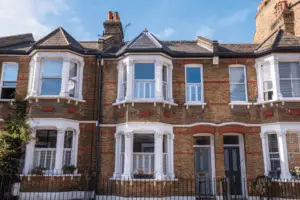
Is A Cottage A House?
A cottage is a small house. A cottage is always a house but a house is not always a cottage.
Different countries have different ideas as to what a cottage is. For example in Scandinavia, a cottage is a bright red wooden affair with a sauna inside.
In Hong Kong, a cottage is a three-story building made of brick with a balcony on the upper floor.
In the United States, the term “cottage” is occasionally used to designate a little vacation home. But not to be confused with an apartment.
However, in the United Kingdom, referring to a home as a “cottage” usually means a small rural home.
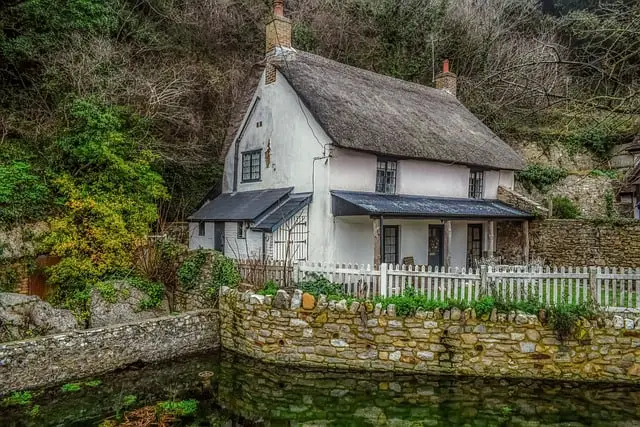
Cottage vs House UK
Cottages and houses in the UK differ in some significant ways. Some of their key differences are discussed below:
Character
They are usually quirky and full of character, rarely one cottage being exactly the same even if built in the same village. The rooms are often small with charming higgledy-piddly layouts.
Rural Location
Cottages are almost exclusively in small rural towns or villages, although as modern towns and cities sprawl out and become ever bigger, listed cottages can often become enveloped by newer development and can now be found right on the edge of more urban areas.
Outside Space
Cottages are almost all detached with a surrounding garden. They don’t have garages or workshops (unless these have been built on as more recent additions).
What Makes a House a Cottage?
Here are some of the main characteristics that make a house a cottage:
- Cottages in the United Kingdom typically are built using a post and beam architecture, which results in low ceilings especially on the first floor which is built into the roof.
- As they are already built into their roof, it is unlikely they have attics of any kind. They are almost always a maximum of two floors being a ground floor and a first floor (more like half of a floor). They rarely have basements.
- Bathrooms and toilets (even in renovated cottages) are often downstairs because of a lack of upstairs space.
- They tend to have a small and narrow staircase with next to no landing.
- The upstairs can have multiple levels: so there is often a need to walk up a step to each bedroom from the tiny (almost non-existent) landing.
- The walls, including the internal walls, are very solid and thick.
So that’s the UK cottage, as you can see there are stark differences between a cottage and a house.
What is Considered a Cottage?
We do go into detail exactly what a cottage in in this article but its important to reiterate this and provide examples so you can really understand the difference in comparison to a house.
A cottage is typically considered a small, cozy dwelling, often found in rural or semi-rural locations. The term “cottage” can be used differently in the UK and USA, with variations in architectural style, size, and materials used for construction.
In the UK:
Thatched cottages: These cottages are characterized by their thatched roofs made of straw, water reed, or similar materials. They often have whitewashed or stone exteriors and are commonly found in rural English villages.
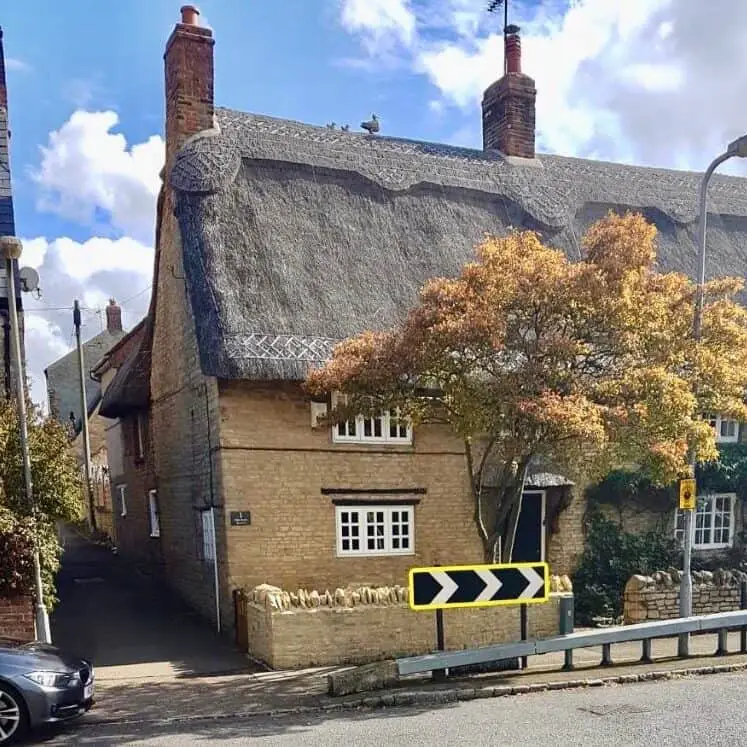
Stone cottages: These are built with local stone materials and often feature slate roofs. They can be found in regions like the Cotswolds, Yorkshire Dales, and the Lake District.
Timber-framed cottages: These cottages have exposed wooden beams, with the spaces between the beams filled with brick or plaster. These are common in areas like Suffolk and Sussex.
In the USA:
Cape Cod cottage: This style of cottage is found in the northeastern United States, particularly in the Cape Cod region of Massachusetts. They typically have steep roofs, wood siding, and simple, symmetrical facades.
Log cabin: These cottages are made from logs, often found in rural or forested areas, and are associated with a rustic, pioneer aesthetic.
Cottage Vs Townhouse – What’s The Difference?
The main differences between a cottage and a townhouse are their architectural styles, location, and the overall living experience they offer. Cottages are small, charming dwellings with a strong connection to nature, typically found in rural or semi-rural settings.
Townhouses, on the other hand, are taller, narrow, multi-story residences built in a row to maximize space, usually located in urban or suburban areas, catering to a more fast-paced, modern lifestyle.
Cottage Definition Real Estate
For our US folk across the pond the definition is slightly different compared to here in the UK. A cottage in real estate terms refers to a small, typically one-story or one-and-a-half-story dwelling, often situated in rural or semi-rural areas.
Characterized by their quaint, charming architecture, cottages usually have a cozy, homey feel with features like a porch or garden. They can serve as primary residences, vacation homes, or rental properties.
In the USA, the term “cottage” often implies a seasonal or vacation property, particularly in regions like the Northeast and Midwest. These dwellings may lack some modern conveniences, underlining their simple, back-to-nature appeal.
Difference Between Cottage and House – Conclusion
In conclusion, the key differences between a cottage vs house can be attributed to factors such as size, location, architectural style, and the lifestyle they represent. Cottages are typically smaller, with a distinct charm and coziness, often nestled in rural or semi-rural settings.
They allow for a closer connection to nature, a simpler way of living, and a slower-paced lifestyle, often characterized by close-knit communities.
Houses, on the other hand, tend to be more spacious and practical, catering to the needs of a growing family. They often feature modern amenities and can be found in a wide range of locations, including suburban and urban areas.
Houses provide greater flexibility in terms of architectural design and adaptability to different lifestyles, while cottages offer a more unique and specific living experience.
Understanding these differences is essential for prospective homeowners when considering their options in terms of property types.
By recognizing the distinct qualities and characteristics of both cottages and houses, individuals can make more informed decisions when it comes to finding a living space that aligns with their preferences and values.
